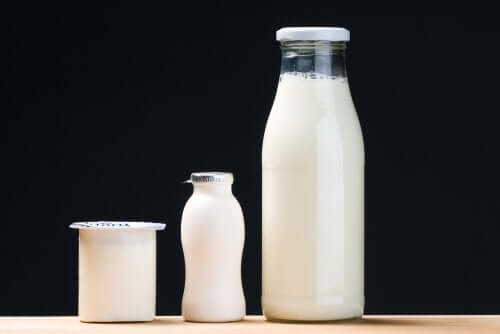Functional Foods for Children

Functional foods, regardless of their nutritional value, have a beneficial effect on health, either improving or reducing the risk of disease. Below, discover what functional foods for children are, as well as their effects.
Functional foods for children
A functional food can be:
- All natural.
- To which a component is added or removed through technology or biotechnology.
- Where the nature of one or more components has been varied.
- Where the bioavailability of one or more of its components has been modified.
- Any combination of the above possibilities.
Probiotics and prebiotics belong to this group; they’re the most commonly used in child nutrition. Probiotics and prebiotics modify the intestinal flora in order to achieve beneficial effects in children.
There’s also the combination of pro and prebiotics, such as synbiotics. They stimulate the selective growth of a limited number of bacteria in the colon.

Probiotics
This group includes living microorganisms (bacteria and yeast) that have a positive effect on health. They’re used in foods such as yogurt, other fermented milk derivatives, or even fermented meat products.
The most widely used microorganisms are lactic acid bacteria (Lactobacillus, Streptococcus, and Bifidobacterium). They have a beneficial action due to the fact that they:
- Cause a more balanced colonic microbiota and prevention of rotavirus diarrhea in infants.
- Compete with pathogenic microorganisms due to their receptors and binding sites.
- Produce cytokines (proteins capable of coordinating immune system response).
- Increase secretory IgA response.
Nowadays, there’s a great interest in showing a relationship between probiotics and the following:
- Prevention and treatment of atopic eczema.
- Treatment of inflammatory bowel disease.
- Prevention of food allergies.
Yogurt
This food is an excellent way to increase calcium and other nutrients’ intake, especially in infants and children who don’t get enough milk or formula.
Yogurt is a type of fermented milk, acidified and coagulated by L. bulgaricus and Streptococcus thermophilus. Adding Lactobacillus casei or other lactobacilli to yogurt seems to increase the proportion of fecal lactobacillus, which is why it could have beneficial effects.
Infant formulas supplemented with probiotics
On the market, there are different types of infant formulas that can be classified according to if they just contain prebiotics, prebiotics plus probiotics, or just probiotics.
The declaration of the European Society for Pediatric Gastroenterology Hepatology and Nutrition (ESPGHAN) approves adding probiotics to follow-up or follow-on formulas but not to first formulas because they’re different species of the baby’s own intestinal flora.
Thus, due to the state of the newborn’s immune system, there can only be follow-up or follow-on formulas with probiotics.

Prebiotics
Another group of functional foods for children are prebiotics. Prebiotics are non-digestible substances that can benefit humans due to the selective stimulation of growth or activity of a group of intestinal bacteria.
At an industrial level, inulin and fructooligosaccharides (FOS) come from chicory, but are also present in wheat, onions, bananas, garlic, and leeks.
Fructooligosaccharides play a role in the development of intestinal bacterial flora. Their fermentation in the colon produces short-chain fatty acids, such as acetic, propionic, and butyric acid:
- They’re a source of energy for the colonocyte.
- They improve the bioavailability of calcium, magnesium, zinc, and iron.
Infant formulas supplemented with prebiotics
Breast milk is rich in complex galactooligosaccharides (GOS), which act as natural prebiotics, promoting the development of bifidobacteria. Therefore, there are infant formulas with prebiotics to mimic the composition of breast milk.
Formulas with FOS and GOS favor the growth of the baby’s own bifidobacteria and lactobacilli, both on top of the colon and at the bottom of it. Due to the fact that flora develops differently in every child, they may be included in both start, follow-up or follow-on, or growth formulas.
https://youaremom.com/health/probiotics-help-children-pregnant-women/
Functional foods, regardless of their nutritional value, have a beneficial effect on health, either improving or reducing the risk of disease. Below, discover what functional foods for children are, as well as their effects.
Functional foods for children
A functional food can be:
- All natural.
- To which a component is added or removed through technology or biotechnology.
- Where the nature of one or more components has been varied.
- Where the bioavailability of one or more of its components has been modified.
- Any combination of the above possibilities.
Probiotics and prebiotics belong to this group; they’re the most commonly used in child nutrition. Probiotics and prebiotics modify the intestinal flora in order to achieve beneficial effects in children.
There’s also the combination of pro and prebiotics, such as synbiotics. They stimulate the selective growth of a limited number of bacteria in the colon.

Probiotics
This group includes living microorganisms (bacteria and yeast) that have a positive effect on health. They’re used in foods such as yogurt, other fermented milk derivatives, or even fermented meat products.
The most widely used microorganisms are lactic acid bacteria (Lactobacillus, Streptococcus, and Bifidobacterium). They have a beneficial action due to the fact that they:
- Cause a more balanced colonic microbiota and prevention of rotavirus diarrhea in infants.
- Compete with pathogenic microorganisms due to their receptors and binding sites.
- Produce cytokines (proteins capable of coordinating immune system response).
- Increase secretory IgA response.
Nowadays, there’s a great interest in showing a relationship between probiotics and the following:
- Prevention and treatment of atopic eczema.
- Treatment of inflammatory bowel disease.
- Prevention of food allergies.
Yogurt
This food is an excellent way to increase calcium and other nutrients’ intake, especially in infants and children who don’t get enough milk or formula.
Yogurt is a type of fermented milk, acidified and coagulated by L. bulgaricus and Streptococcus thermophilus. Adding Lactobacillus casei or other lactobacilli to yogurt seems to increase the proportion of fecal lactobacillus, which is why it could have beneficial effects.
Infant formulas supplemented with probiotics
On the market, there are different types of infant formulas that can be classified according to if they just contain prebiotics, prebiotics plus probiotics, or just probiotics.
The declaration of the European Society for Pediatric Gastroenterology Hepatology and Nutrition (ESPGHAN) approves adding probiotics to follow-up or follow-on formulas but not to first formulas because they’re different species of the baby’s own intestinal flora.
Thus, due to the state of the newborn’s immune system, there can only be follow-up or follow-on formulas with probiotics.

Prebiotics
Another group of functional foods for children are prebiotics. Prebiotics are non-digestible substances that can benefit humans due to the selective stimulation of growth or activity of a group of intestinal bacteria.
At an industrial level, inulin and fructooligosaccharides (FOS) come from chicory, but are also present in wheat, onions, bananas, garlic, and leeks.
Fructooligosaccharides play a role in the development of intestinal bacterial flora. Their fermentation in the colon produces short-chain fatty acids, such as acetic, propionic, and butyric acid:
- They’re a source of energy for the colonocyte.
- They improve the bioavailability of calcium, magnesium, zinc, and iron.
Infant formulas supplemented with prebiotics
Breast milk is rich in complex galactooligosaccharides (GOS), which act as natural prebiotics, promoting the development of bifidobacteria. Therefore, there are infant formulas with prebiotics to mimic the composition of breast milk.
Formulas with FOS and GOS favor the growth of the baby’s own bifidobacteria and lactobacilli, both on top of the colon and at the bottom of it. Due to the fact that flora develops differently in every child, they may be included in both start, follow-up or follow-on, or growth formulas.
https://youaremom.com/health/probiotics-help-children-pregnant-women/
All cited sources were thoroughly reviewed by our team to ensure their quality, reliability, currency, and validity. The bibliography of this article was considered reliable and of academic or scientific accuracy.
- Ewaschuk, J. B., & Dieleman, L. A. (2006). Probiotics and prebiotics in chronic inflammatory bowel diseases. World journal of gastroenterology, 12(37), 5941–5950.
- Manual práctico de nutrición en pediatría. (2007) . Asociación española de pediatría.
- Moro, G., Minoli, I., Mosca, M., Fanaro, S., Jelinek, J., Stahl, B., & Boehm, G. (2002). Dosage-related bifidogenic effects of galacto-and fructooligosaccharides in formula-fed term infants. Journal of pediatric gastroenterology and nutrition, 34(3), 291-295.
- Oliveros Leal, L., & Moreno Villares, J. M. (n.d.). Prebióticos en fórmulas infantiles. Anales de Pediatría, Unidad Clínica del Hospital, 12.
- Vitoria Miñana I. (2006). Alimentos funcionales en pediatría. En:AEPap ed. Curso de Actualización Pediatría 2006. Madrid: Exlibris Ediciones; 2006. p. 111-7.
This text is provided for informational purposes only and does not replace consultation with a professional. If in doubt, consult your specialist.








